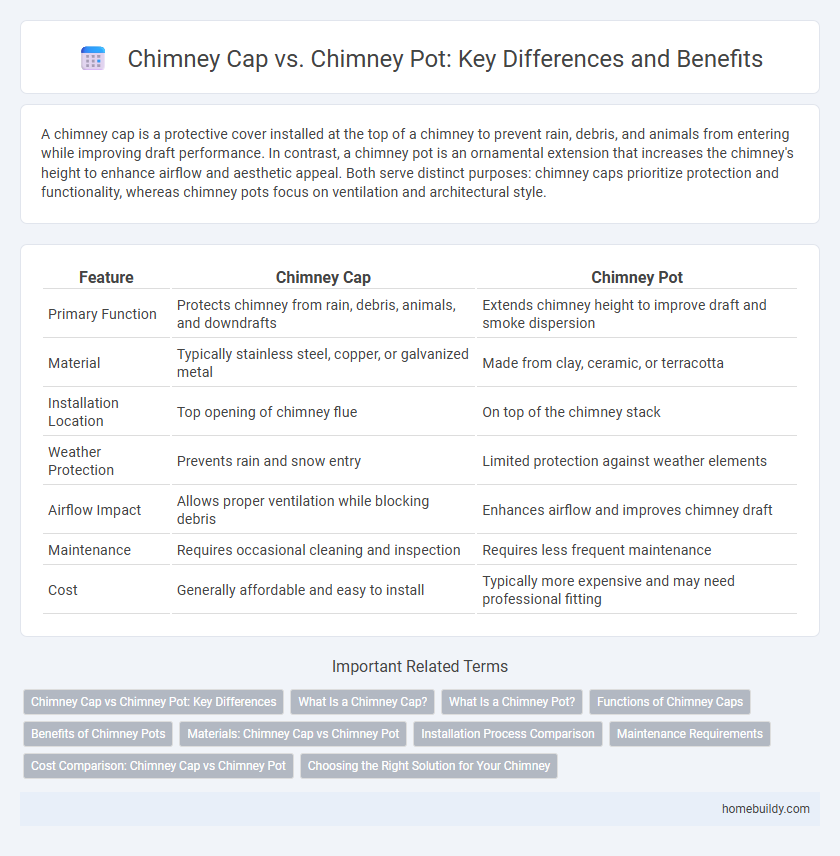A chimney cap is a protective cover installed at the top of a chimney to prevent rain, debris, and animals from entering while improving draft performance. In contrast, a chimney pot is an ornamental extension that increases the chimney's height to enhance airflow and aesthetic appeal. Both serve distinct purposes: chimney caps prioritize protection and functionality, whereas chimney pots focus on ventilation and architectural style.
Table of Comparison
| Feature | Chimney Cap | Chimney Pot |
|---|---|---|
| Primary Function | Protects chimney from rain, debris, animals, and downdrafts | Extends chimney height to improve draft and smoke dispersion |
| Material | Typically stainless steel, copper, or galvanized metal | Made from clay, ceramic, or terracotta |
| Installation Location | Top opening of chimney flue | On top of the chimney stack |
| Weather Protection | Prevents rain and snow entry | Limited protection against weather elements |
| Airflow Impact | Allows proper ventilation while blocking debris | Enhances airflow and improves chimney draft |
| Maintenance | Requires occasional cleaning and inspection | Requires less frequent maintenance |
| Cost | Generally affordable and easy to install | Typically more expensive and may need professional fitting |
Chimney Cap vs Chimney Pot: Key Differences
Chimney caps are metal covers installed on top of chimneys to prevent rain, debris, and animals from entering the flue, while chimney pots are decorative clay or metal extensions that increase chimney height and improve draft. Caps typically feature mesh screens for ventilation and spark arresting, whereas pots focus more on enhancing airflow and aesthetic appeal. Understanding the functional role of chimney caps versus the decorative and draft-enhancing purpose of chimney pots is essential for optimal chimney performance and safety.
What Is a Chimney Cap?
A chimney cap is a protective covering installed atop a chimney to prevent rain, debris, animals, and downdrafts from entering the flue. Unlike a chimney pot, which primarily extends the chimney height and improves draft, a chimney cap focuses on shielding and ventilation. Properly fitted chimney caps enhance safety by reducing fire hazards and preserving chimney integrity.
What Is a Chimney Pot?
A chimney pot is a cylindrical extension made of clay or metal, installed atop a chimney to improve draft and prevent downdrafts. Unlike a chimney cap, which typically includes a cover and mesh to block rain, debris, and animals, a chimney pot primarily enhances airflow and extends the flue height. Installing a chimney pot is common in traditional chimneys, especially in European architecture, where it helps optimize smoke expulsion.
Functions of Chimney Caps
Chimney caps serve a crucial role in preventing rain, debris, and animals from entering the chimney, thereby protecting the flue and improving overall safety and efficiency. Unlike chimney pots that primarily extend the height of the chimney to enhance draft, chimney caps also help reduce downdrafts and minimize sparks escaping, reducing fire hazards. Their mesh construction allows for ventilation while blocking unwanted elements, making them essential for maintaining chimney integrity.
Benefits of Chimney Pots
Chimney pots enhance draft efficiency by increasing the height of the chimney, which improves airflow and reduces smoke backflow. Made from durable materials like clay or metal, chimney pots provide superior protection against rain, debris, and animals, preventing blockages and damage. Their traditional and aesthetic design also adds architectural character to the property while requiring low maintenance.
Materials: Chimney Cap vs Chimney Pot
Chimney caps are commonly made from durable materials such as stainless steel, galvanized steel, or copper, offering excellent corrosion resistance and longevity. Chimney pots, traditionally crafted from terracotta or clay, provide a classic aesthetic but may be more susceptible to weathering and damage over time. The choice of material significantly impacts the function and durability, with metal caps prioritizing protection against elements and clay pots focusing on enhancing draft and style.
Installation Process Comparison
The installation process of a chimney cap typically involves securing a metal or mesh cover over the chimney flue to prevent debris, animals, and water from entering, usually requiring minimal tools and time. In contrast, installing a chimney pot demands more extensive masonry skills as it involves placing a ceramic or clay extension atop the chimney stack to enhance draft and aesthetic appeal. While chimney caps offer a straightforward, adjustable fit for various flue sizes, chimney pots require precise handling and anchoring to withstand weather conditions and ensure structural integrity.
Maintenance Requirements
Chimney caps require minimal maintenance, typically involving periodic cleaning to remove debris and inspection for rust or damage to ensure proper protection against rain and animals. Chimney pots, often made from clay or terracotta, need more frequent checks for cracks or erosion due to weather exposure, which can affect their durability and function. Proper maintenance of both components extends chimney lifespan, but caps generally demand less frequent and less intensive care compared to chimney pots.
Cost Comparison: Chimney Cap vs Chimney Pot
Chimney caps generally cost between $50 and $200 depending on materials like stainless steel or copper, making them a more economical choice compared to chimney pots, which can range from $150 to $500 or more due to their larger size and ornamental designs. Installation costs for chimney caps average $100 to $300, while chimney pots may incur higher labor charges because of their weight and complexity. Homeowners seeking functional protection at a lower expense often prefer chimney caps, whereas chimney pots serve both aesthetic and ventilation purposes despite their higher price point.
Choosing the Right Solution for Your Chimney
A chimney cap provides essential protection by preventing rain, debris, and animals from entering the flue, while a chimney pot primarily extends the chimney's height to improve draft and disperse smoke more effectively. Selecting the right solution depends on your chimney's structural needs and environmental conditions, with chimney caps being ideal for weather protection and pots enhancing ventilation. Assessing local climate, chimney type, and functional requirements ensures optimal performance and longevity for your chimney system.
Chimney cap vs Chimney pot Infographic

 homebuildy.com
homebuildy.com